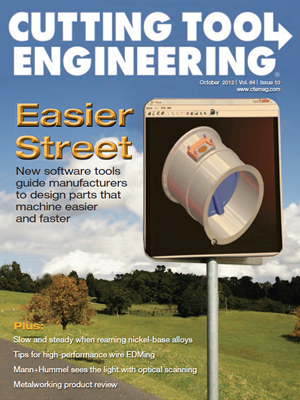----------------
END USER: K-Fab Inc., (408) 727-5311, www.k-fabinc.com. CHALLENGE: Increase spindle utilization for a vertical machining center while reducing labor requirements. SOLUTION: A nonrobotic automation system for VMCs. SOLUTION PROVIDER: Simons Design Innovation, (408) 398-3296, www.simonsdesigninnovation.com
----------------
Perplexed by the lack of nonrobotic automation for vertical machining centers, which require an operator to clamp and unclamp the vice at the correct moment to achieve a high spindle utilization rate, Steve Simons, president of Simons Design Innovation, decided to do something about it. He noted prior, documented attempts to automate VMCs failed to overcome obstacles with vice cleaning, stock positioning and workpiece clamping.
Involved in the manufacturing industry since the 1970s, including starting the RockShox bicycle suspension company, Simons began mulling how to achieve VMC automation about a decade ago. His Mountain View, Calif., company then built a working prototype in 2010 and launched Smart Valet Model SV-1 in May at an event held at K-Fab Inc., a parts manufacturer in Santa Clara, Calif.
The automation system integrates with virtually all VMCs and takes about 5 hours to install, according to Simons. He explained that an operator begins the machining process by placing workpieces on a conveyor belt, which delivers them to the machine. A programmable logic controller opens and closes a machine’s door and vice, and an actuator cleans the vice and feeds stock into the vice. After a part is machined, it’s moved to an unload station where the actuator pulls the part from the vice and places it onto an ejection tray. The cycle then repeats.

Images courtesy of Simons Design Innovation
Steve Simons, president of Simons Design Innovation, developed the Smart Valet for automating VMCs.

“The ejection tray acts both as a conveyor to bring the part out of the machine and a drain board to remove oil or water and return it to the machine,” Simons said.
The standard model has a 3½ ' conveyor belt, which Simons noted holds enough parts for 2 to 8 hours of machining, depending on the cycle time. Accessories are available to extend the queue, such as a side loader to stock more workpiece material beside the belt. “When material from the belt is exhausted, we push another row on,” Simons said. “It’s a compact way to store material.”
The machine comes standard with sensors that detect if workpiece material is depleted or incorrectly fed. In addition, detection systems can be integrated to check for worn or broken cutting tools, chip buildup in the machine and adequate coolant supply.
Although there is no workpiece weight limitation, the workpiece must fit into an 8 " cube. “The smallest we’re capable of handling is slightly under an inch,” Simons said.
He noted switching the system from one part to the next takes less than 5 minutes.
The standard Smart Valet costs $29,000, with payback typically within 12 to 24 weeks, and will increase a shop’s productivity at least 14 percent, according to Simons.
An early adopter since March, K-Fab realized at least 20 percent more output with a Smart Valet, which Simons Design integrated with K-Fab’s Haas DT-1 VMC. Simons Design also provided the required workholding and sheet metal, according to Mike Kedell, company president and CEO. He noted an employee initially informed him about the automation system after seeing a video on YouTube.
K-Fab also investigated a part-loading robot to reduce labor by having the machine run unattended while increasing spindle utilization, but decided it was too complex to program, not as flexible as Smart Valet and cost-prohibitive, Kedell said. “So long as there is material on the Smart Valet conveyor, we are running at 100 percent spindle utilization.”
Kedell added that Smart Valet requires minimal manpower to operate and enables some lights-out machining. “When the folks go home, the machine keeps running,” he said.
K-Fab realized a return on investment in 17 weeks, Kedell noted, but the company isn’t the only one pleased with the system’s success. “This has allowed us to pass cost reductions onto our customers,” he said. CTE
Related Glossary Terms
- centers
centers
Cone-shaped pins that support a workpiece by one or two ends during machining. The centers fit into holes drilled in the workpiece ends. Centers that turn with the workpiece are called “live” centers; those that do not are called “dead” centers.
- coolant
coolant
Fluid that reduces temperature buildup at the tool/workpiece interface during machining. Normally takes the form of a liquid such as soluble or chemical mixtures (semisynthetic, synthetic) but can be pressurized air or other gas. Because of water’s ability to absorb great quantities of heat, it is widely used as a coolant and vehicle for various cutting compounds, with the water-to-compound ratio varying with the machining task. See cutting fluid; semisynthetic cutting fluid; soluble-oil cutting fluid; synthetic cutting fluid.
- machining center
machining center
CNC machine tool capable of drilling, reaming, tapping, milling and boring. Normally comes with an automatic toolchanger. See automatic toolchanger.

